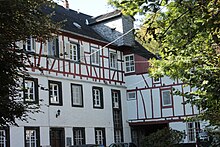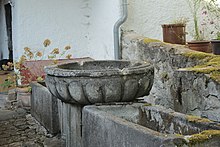Lukasmühle (Mülheim-Kärlich)
The Lukasmühle (formerly Lucasmühle ) is a historic watermill on the Lützelbach , consisting of a former mill building and residential buildings with an adjoining outdoor area and the Lukasweiher. It is located between Mülheim-Kärlich and Bassenheim near Koblenz .
history
In 1667 the intention was to build a grinding mill on the large pond in the Kärlich district. The direct predecessor of today's Lukasmühle was an electoral play mill , which was not used for commercial purposes , but, together with the adjoining " orangery ", as a pleasure house for furnishing the large electoral garden.
The oldest, still preserved buildings of the Lukas mill, an oil and grinding mill, were built in the 18th century and belonged to the property of the last elector of Trier, Clemens Wenzeslaus of Saxony , who also resided in the nearby electoral castle of Kärlich Hunting lodge of the Trier electors. After the loss of most of the electoral state on the left bank of the Rhine as a result of the French Revolution , the conquest by General Marceau in 1793 and the end of Kurtrier , the mill and the adjoining park including the "Great Pond" were taken over by the family in 1803 as part of the secularization due to the Reichsdeputation Hauptschluss Lucas acquired. This soon resulted in the popular name for both the mill and the pond.
The Lucas family had built an oil mill with a fish pond at this point . The entire property later passed to a Johann Jakob Zerfaß from Rübenach ; his eldest daughter and heiress married an Augustin Dötsch who took over the mill. In the meantime the business had been converted to a flour mill . The daughters of August Dötsch finally gave up the milling operation.
In the meantime, their descendants (the Riechert family) took over the property and expanded it to include additional buildings, extensions and a barn; since then it has been owned by the Riechert family.
The electoral fountain of the Lukasmühle in front of the main building still reminds of the beginnings of the mill under the Electors of Trier. The main house, a three-storey half-timbered house, partly solidly bricked and provided with a half- hipped roof , belongs to the listed complex . An inscription indicates the year 1780 as the year of construction. This includes extensions, another half-timbered house and economic wings.
Mills in the valley of the Lützelbach
There are still some mill buildings, which are now used consistently as residential buildings, on the Lützelbach, which flows from Bassenheim through Mülheim-Kärlich. In addition to the Lukasmühle, the Karlsmühle, the Korbsmühle, the Heckenmühle and the Waldmühle.
Individual evidence
- ↑ See Johann Daniel Friedrich Rumpf: Complete Topographical Dictionary of the Prussian State, Volume 4 , 1824
- ↑ See Leopold Krug: New topographical-statistical-geographical dictionary of the Prussian state. Volume 3 , 1801
- ↑ H. Rudolph: Most complete geographical-topographical-statistical local dictionary, Volume 2 : 1864
- ↑ Notes on studies on Germania sacra, Volume 6 . Vandenhoeck u. Ruprecht, 1967
- ^ A b Winfried Henrichs and Karl-Heinz Reif: Mills in the Mülheim-Kärlicher Bachtal. Kn: Winfried Henrichs (Ed.): Mülheim-Kärlich. 1981, pp. 222-227
- ↑ MK4 Mühlenweg Mülheim - Korbs-Mühle - rain retention basin at VG Weißenthurm


